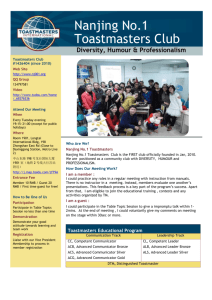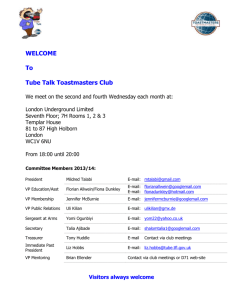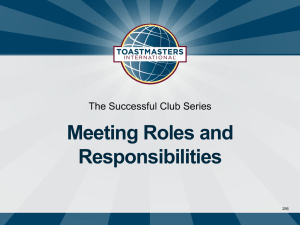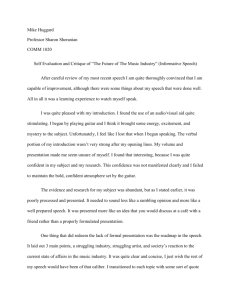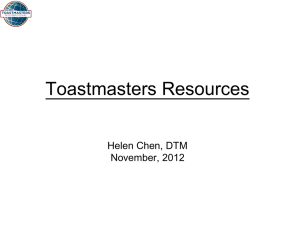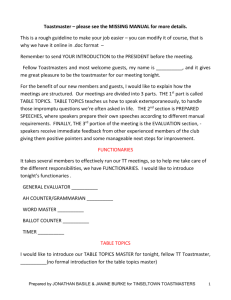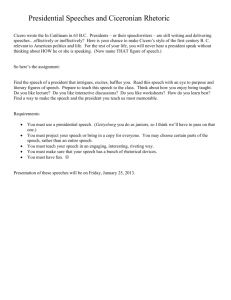A club guest welcome packet
advertisement
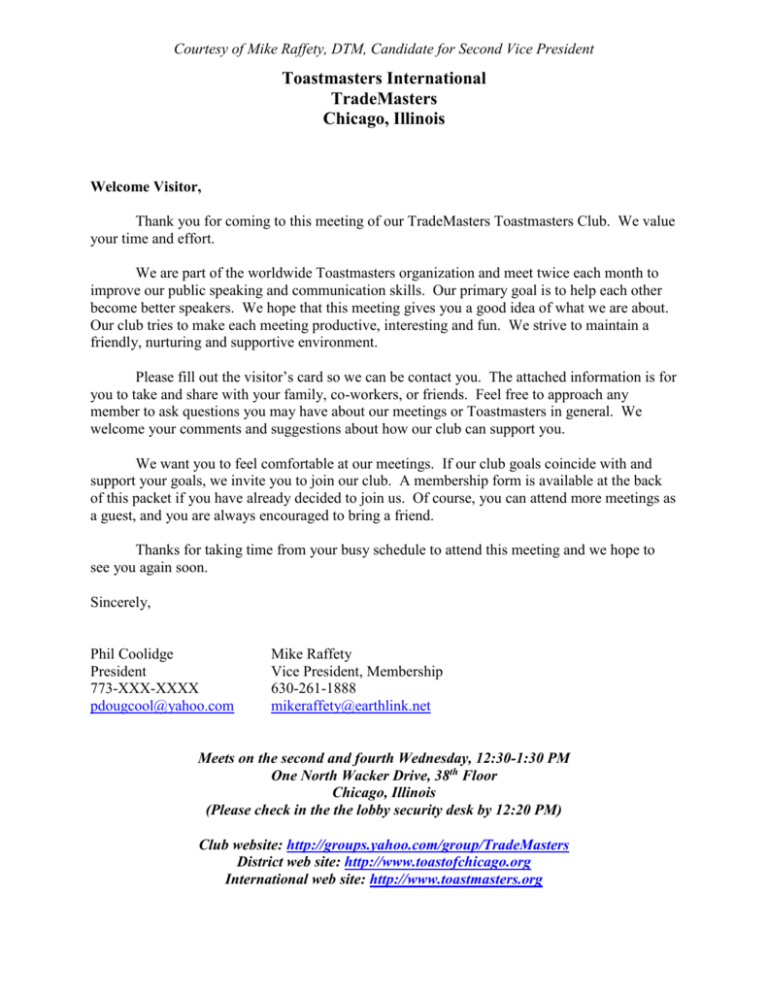
Courtesy of Mike Raffety, DTM, Candidate for Second Vice President Toastmasters International TradeMasters Chicago, Illinois Welcome Visitor, Thank you for coming to this meeting of our TradeMasters Toastmasters Club. We value your time and effort. We are part of the worldwide Toastmasters organization and meet twice each month to improve our public speaking and communication skills. Our primary goal is to help each other become better speakers. We hope that this meeting gives you a good idea of what we are about. Our club tries to make each meeting productive, interesting and fun. We strive to maintain a friendly, nurturing and supportive environment. Please fill out the visitor’s card so we can be contact you. The attached information is for you to take and share with your family, co-workers, or friends. Feel free to approach any member to ask questions you may have about our meetings or Toastmasters in general. We welcome your comments and suggestions about how our club can support you. We want you to feel comfortable at our meetings. If our club goals coincide with and support your goals, we invite you to join our club. A membership form is available at the back of this packet if you have already decided to join us. Of course, you can attend more meetings as a guest, and you are always encouraged to bring a friend. Thanks for taking time from your busy schedule to attend this meeting and we hope to see you again soon. Sincerely, Phil Coolidge President 773-XXX-XXXX pdougcool@yahoo.com Mike Raffety Vice President, Membership 630-261-1888 mikeraffety@earthlink.net Meets on the second and fourth Wednesday, 12:30-1:30 PM One North Wacker Drive, 38th Floor Chicago, Illinois (Please check in the the lobby security desk by 12:20 PM) Club website: http://groups.yahoo.com/group/TradeMasters District web site: http://www.toastofchicago.org International web site: http://www.toastmasters.org The Toastmasters Experience and How It Works The Toastmasters program is not a college, trade school, or other formal course in public speaking. There are no instructors, professors, or classrooms. No one’s work is graded and no tests are administered. In Toastmasters, members learn by studying the manuals, practicing, and helping one another. Learning takes place in the Club environment. Club meetings are workshops where you study and practice communication and leadership skills with others who are there for the same reason as you. You learn by doing and by watching fellow Club members. During Club meetings you will build “quick thinking” skills as you give one-to-two-minute speeches on general subjects during table topics. You’ll introduce speakers, conduct meetings and perform other roles that will give you plenty of practice in a variety of communication experiences, but your greatest learning will come from preparing and presenting speeches based on the projects in the manual. The manual has 10 speech projects, each designed to develop your speaking skills one step at a time. Every project builds upon what you have learned in the preceding project, so you should present the speeches in numerical order. The first speech is the Ice Breaker, the subject is yourself. In subsequent speeches you will learn the importance of speaking sincerely, how to effectively organize a presentation, how to use body language and voice to convey your message, word choice and props. Read carefully each project and “Evaluation Guide” in your workbook before you prepare your speech. Most of your talks will be 5-7 minutes. You will receive verbal and written feedback from an evaluator on each speech you give. The evaluator provides a personal opinion of your talk, pointing out its strengths and offering suggestions for improving your next speech. As you gain more experience you will evaluate the speeches of others. The Mission of the Club … Is to provide a mutually supportive and positive learning environment in which every member has the opportunity to develop communication and leadership skills, which in turn foster selfconfidence and personal growth. Your First Meeting In order to benefit from your first meeting, please: Applaud at the introduction of each speaker and again at the end of the speech (this is the Toastmaster equivalent of a group hug). It is part of the nurturing environment that grows personal progress. Write some comments on the small speech evaluation form for each speaker. If you’re willing, speak in response to table topic questions. Ask questions of the members before and after the meeting. Let us know how our club can help you achieve your goals. Tell us your reaction to the meeting. Plan to return for a second look. You have taken an important first step towards improving your communication skills by asking about our program. The next steps are: Determine where you stand as a speaker and form a written plan for the areas you want to improve in. Participate in our next meeting and talk with a mentor. We welcome your questions and your input. Cast of Characters When you attend your first few meetings it will be helpful to know the cast of characters. Other than the Presiding Officer, people volunteering at a previous meeting fill all the positions. Toastmaster of the Day: The master of ceremonies; The Toastmaster introduces the various participants in the meeting and leads the meeting. Wordmaster: A member presents a vocabulary-building word with definition and usage. The goal is for everyone who speaks to use the new word. Jokemaster: A member presents a humorous story or joke, because being able to use humor well is a very important skill. Timer: Because one of the purposes of Toastmasters is to ensure our members learn how to express a thought within a specific time, the time keeper times, records and reports the time used by each table topic speaker, speaker, and evaluator. Ah So Grammarian: Checks participants’ grammar and counts audible pauses such as “ah”, “uh” and “you know”. This person also praises participants for using the word of the day. Speakers: Typically there are two to four speakers. Each one gives a prepared manual speech, usually 5 to 7 minutes. Each speech has specific objectives that are listed in the basic manual (that's why it's called a manual speech). Table Topics Master: The table topic master helps members practice thinking on their feet. He selects topics of general interest and asks questions of members in the audience (you may be asked to participate). General Evaluator: Provides constructive feedback on the meeting in general. He or she is in charge of the individual evaluators, the timer, and the grammarian. Evaluators: The purpose of the evaluator is to motivate the speaker to both continue speaking and to improve. The evaluator lets the speaker know what areas he has excelled in, and also offers a few constructive suggestions to help the speaker improve. The evaluator gives an oral review as well as a written review in the speaker’s manual. Cost of Membership So how much does all this cost? The new membership fee varies based on the time of year that you join. New members are required to pay: A new membership fee of $20.00. This payment goes to Toastmasters International and pays for your Competent Toastmaster manual as well as other new member materials; A monthly Toastmaster International membership fee of $4.50. This fee is prorated according to the month that you join and is calculated using the schedule below: o o o o o o October or April November or May December or June January or July February or August March or Sept. $27.00 $22.50 $18.00 $13.50 $ 9.00 $ 4.50 A monthly club membership fee of $1.50. This fee is also prorated according to the month that you join. This fee helps us pay for club operations, club supplies, awards and so on. The fee schedule is below. o o o o o o October or April November or May December or June January or July February or August March or Sept. $9.00 $7.50 $6.00 $4.50 $3.00 $1.50 The table below shows the initial membership fee based on month of the year joined: Month joined January February March April May June July August September October November December New member fee $20.00 $20.00 $20.00 $20.00 $20.00 $20.00 $20.00 $20.00 $20.00 $20.00 $20.00 $20.00 Int’l dues $13.50 $9.00 $4.50 $27.00 $22.50 $18.00 $13.50 $9.00 $4.50 $27.00 $22.50 $18.00 Club dues $4.50 $3.00 $1.50 $9.00 $7.50 $6.00 $4.50 $3.00 $1.50 $9.00 $7.50 $6.00 Total $38.00 $32.00 $26.00 $56.00 $50.00 $44.00 $38.00 $32.00 $26.00 $56.00 $50.00 $44.00 Once you have paid these initial membership fees (regardless of the month paid) you will be required to pay fixed semi-annual membership dues of $36.00 by October 1 and April 1 of each year. The reason the initial membership fees vary based on the month of the year joined is to get every new member on this semiannual membership dues schedule. These dues pay for six months of $4.50 monthly dues to Toastmaster International ($27.00) and for six months of $1.50 monthly dues to the local club ($9.00). Please make checks payable to TradeMasters; sorry, we’re not prepared to accept credit cards at this time (regardless of the space on the form). What You Receive for Your New Member Fee Within two weeks, you will receive a New Member Packet from Toastmasters International in Mission Viejo, CA. This packet will contain: Communication and Leadership Program Manual (see below) Effective Speech Evaluation Manual (tips and techniques for giving helpful evaluations) Your Speaking Voice Manual (tips for adding strength and authority to your voice) Gestures: Your Body Speaks Manual (how to become skilled in nonverbal communication) If you do not receive this packet within two weeks, please let the Vice President Membership or the President know. The Communications and Leadership Manual During your membership in Toastmasters, you will be encouraged to complete the 10 manual speeches from the Communication and Leadership Program manual. Although you will pick the specific topic yourself for each of those speeches, each speech has several objectives. The manual and other materials that you will be given will help you achieve these objectives. We have listed them below – so that you can see for yourself the types of skills you will be striving to improve. Each speech's objectives build on the skills you learned in the previous speeches, so it's very important that you do them in order. Speech Name and time 1 The ice breaker TIME: 4 - 6 minutes. 2 Organize your speech TIME: 5 - 7 minutes. 3 Get to the point TIME: 5 - 7 minutes. 4 How to say it TIME: 5 - 7 minutes. 5 Your body speaks TIME: 5 - 7 minutes. 6 Vocal variety TIME: 5 - 7 minutes. 7 Research your topic TIME: 5 - 7 minutes. Objectives To begin speaking before an audience. To discover speaking skills you already have and skills that need some attention To introduce yourself to your fellow club members. Select an appropriate outline which allows listeners to easily follow and understand your speech. Make your message clear, with supporting material directly contributing to that message. Use appropriate transitions when moving from one idea to another. Create a strong opening and conclusion. Organize the speech in a manner that best achieves those purposes. Ensure the beginning, body, and conclusion reinforce the purpose. Project sincerity and conviction and control any nervousness you may feel. Strive not to use notes. Select the right words and sentence structure to communicate your ideas clearly, accurately and vividly. Use rhetorical devices to enhance and emphasize ideas. Eliminate jargon and unnecessary words. Use correct grammar. Use stance, movement, gestures, facial expressions and eye contact to express your message and achieve your speech's purpose. Make your body language smooth and natural. Use voice volume, pitch, rate and quality to reflect and add meaning and interest to your message. Use vocal variety smoothly and naturally. Collect information about your topic from numerous sources. Carefully support your points and opinions with specific facts, examples and illustrations gathered through research. Visual aids TIME: 5 - 7 minutes. Select visual aids that are appropriate for your message and the audience. Use visual aids correctly with ease and confidence. 9 Persuade with power 5 - 7 minutes. 10 Inspire your audience TIME: 5 - 7 minutes. Persuade listeners to adopt your viewpoint or ideas or to take some action. Appeal to the audience's interests. Use logic and emotion to support your position. Avoid using notes. To inspire the audience by appealing to noble motives and challenging the audience to achieve a higher level of beliefs or achievement. Appeal to the audience's needs and emotions, using stories, anecdotes and quotes to add drama. Avoid using notes. After a member completes all ten basic manual speeches above, thus earning the designation of Competent Toastmaster (CTM), they continue by giving advanced speeches from their choice of the advanced manuals: Humorously Speaking: How to warm up your audience, leave them with a smile, make them laugh, keep them laughing, and the humorous speech. The Entertaining Speaker: How to give an entertaining or dramatic speech, where to find material, how to make an audience laugh, and what to do when you're asked to speak after dinner. Speaking to Inform: How to give a demonstration talk, the fact-finding report, the abstract concept, and resources for informing. Public Relations: Building goodwill through public speaking, persuading an audience, speaking to a hostile audience, and speaking to the media. The Discussion Leader: Provides instruction in the four different methods of leading a group discussion. An ideal manual for managers, trainers, and administrators. Specialty Speeches: Covers impromptu speeches, sales presentations, introductions, inspirational speeches, and oral interpretations. Speeches By Management: How to handle a variety of speaking situations managers encounter in the work environment. Topics include: briefings, technical speeches, motivational speeches, and status reports. The Professional Speaker: Covers the keynote address, the entertaining speech, sales training speech, the seminar and the motivational speech. Technical Presentations: Covers the technical briefing, the proposal, speaking to the non-technical audience, presenting a technical paper, and giving a "team" technical presentation. Persuasive Speaking: The ability to influence and persuade others to accept your ideas, products, or services is vital. The projects in this manual are all designed to help you develop excellent persuasive techniques and expand your presentation skills. Communicating on Television: How to present editorials, guest/interview programs, press conference, and training via television. Storytelling: How to tell a folk tale, personal story, stories with morals, touching stories, and the historical story. Interpretive Reading: Instruction in interpretive reading skills: presentation of stories, poetry, monodrama, plays and oratorical speeches. Interpersonal Communications: Build strong interpersonal communication skills including: conversing with ease, handling criticism, negotiating, coaching to improve performance, and expressing dissatisfaction effectively. Special Occasion Speeches: Provides instruction in giving toasts, speaking in praise, "roasting" someone, and presenting or accepting awards.
